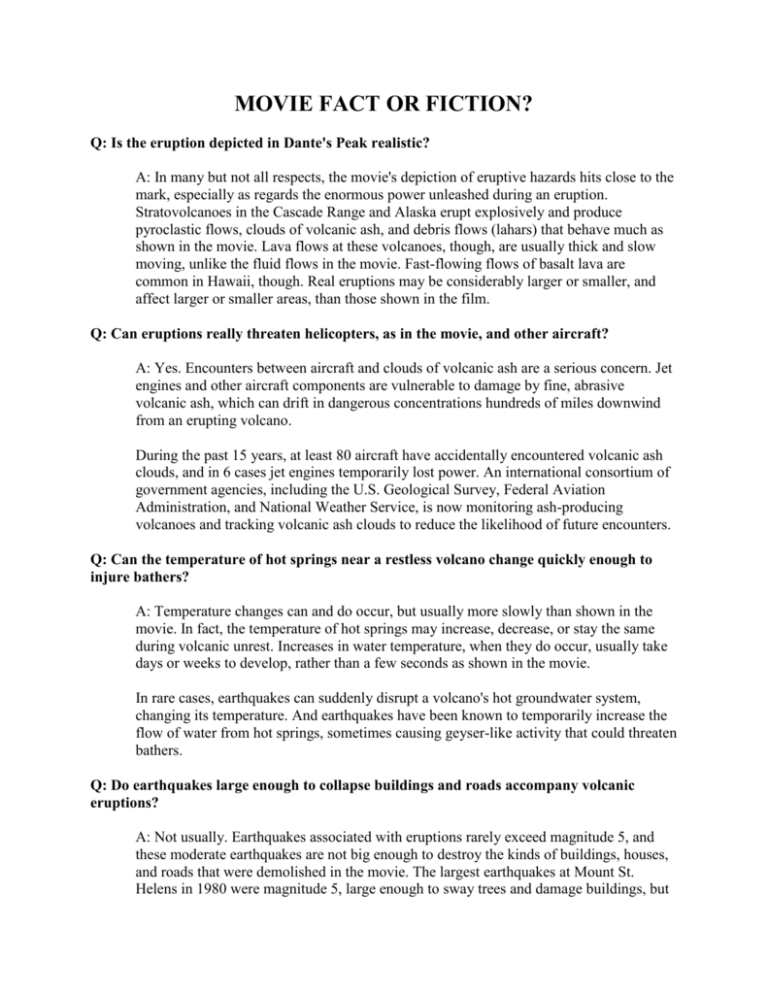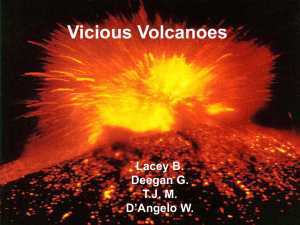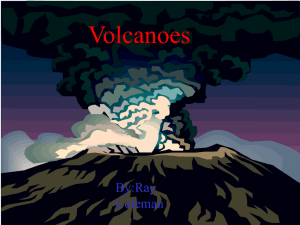movie fact or fiction?
advertisement

MOVIE FACT OR FICTION? Q: Is the eruption depicted in Dante's Peak realistic? A: In many but not all respects, the movie's depiction of eruptive hazards hits close to the mark, especially as regards the enormous power unleashed during an eruption. Stratovolcanoes in the Cascade Range and Alaska erupt explosively and produce pyroclastic flows, clouds of volcanic ash, and debris flows (lahars) that behave much as shown in the movie. Lava flows at these volcanoes, though, are usually thick and slow moving, unlike the fluid flows in the movie. Fast-flowing flows of basalt lava are common in Hawaii, though. Real eruptions may be considerably larger or smaller, and affect larger or smaller areas, than those shown in the film. Q: Can eruptions really threaten helicopters, as in the movie, and other aircraft? A: Yes. Encounters between aircraft and clouds of volcanic ash are a serious concern. Jet engines and other aircraft components are vulnerable to damage by fine, abrasive volcanic ash, which can drift in dangerous concentrations hundreds of miles downwind from an erupting volcano. During the past 15 years, at least 80 aircraft have accidentally encountered volcanic ash clouds, and in 6 cases jet engines temporarily lost power. An international consortium of government agencies, including the U.S. Geological Survey, Federal Aviation Administration, and National Weather Service, is now monitoring ash-producing volcanoes and tracking volcanic ash clouds to reduce the likelihood of future encounters. Q: Can the temperature of hot springs near a restless volcano change quickly enough to injure bathers? A: Temperature changes can and do occur, but usually more slowly than shown in the movie. In fact, the temperature of hot springs may increase, decrease, or stay the same during volcanic unrest. Increases in water temperature, when they do occur, usually take days or weeks to develop, rather than a few seconds as shown in the movie. In rare cases, earthquakes can suddenly disrupt a volcano's hot groundwater system, changing its temperature. And earthquakes have been known to temporarily increase the flow of water from hot springs, sometimes causing geyser-like activity that could threaten bathers. Q: Do earthquakes large enough to collapse buildings and roads accompany volcanic eruptions? A: Not usually. Earthquakes associated with eruptions rarely exceed magnitude 5, and these moderate earthquakes are not big enough to destroy the kinds of buildings, houses, and roads that were demolished in the movie. The largest earthquakes at Mount St. Helens in 1980 were magnitude 5, large enough to sway trees and damage buildings, but not destroy them. During the huge eruption of Mount Pinatubo in the Philippines in 1991, dozens of light to moderate earthquakes (magnitude 3 to 5) were felt by several hundred thousand people. Many houses collapsed, but not primarily because of the shaking. Heavy, wet ash from the eruption and a hurricane accumulated on roofs and crushed them. Stronger earthquakes sometimes DO occur near volcanoes as a result of tectonic faulting. For example, four magnitude 6 earthquakes struck Long Valley caldera, California, in 1980, and a magnitude 7.2 earthquake struck Kilauea Volcano, Hawaii, in 1975. Both volcanoes were quiet at the time. The Hawaii earthquake triggered a small eruption at the summit of Kilauea. No eruption has yet occurred at Long Valley, but the area has been restless since the 1980 earthquakes. Q: Can a town's water supply become contaminated when a volcano is restless? A: Yes, but probably not as quickly as shown in the movie. If a town's water supply originates directly from a volcano's groundwater system or from a stream that has been covered with volcanic ash, the water could become contaminated with foul-smelling gases or fine ash and other sediment. Some volcanic gases such as sulfur dioxide dissolve in groundwater, making the water acidic. Sulfurous odors, however, are caused by hydrogen sulfide gas, which smells like rotten eggs. Q: Do scientists drive across moving lava flows? A: No. Any attempt to drive across an active lava flow, even one that has partly solidified to form a thin crust, is likely to lead to disaster. With a temperature of 1,700 degrees Fahrenheit or higher, fresh lava will quickly melt rubber tires and ignite gas tanks. And if a vehicle gets stuck in moving lava, well, you know the rest of the story. Q: Can carbon dioxide gas from volcanoes kill trees and wildlife? A: Yes. At several volcanoes around the world, carbon dioxide gas released from magma has accumulated in the soil in sufficient concentrations to kill vegetation or has collected in low areas and suffocated animals. At Mammoth Mountain in California, carbon dioxide has killed about 100 acres of trees since 1989, and visitors to this area have occasionally suffered symptoms of asphyxiation when entering cabins or below- ground excavations. USGS scientists have concluded that the gas is escaping from a magma body beneath Mammoth Mountain. The magma itself is not currently moving toward the surface, but the USGS is monitoring the situation carefully. Q: Can volcanoes suddenly become restless and erupt within one week of the first signs of activity? A: Yes. The first steam eruption at Mount St. Helens on March 27, 1980, was preceded by only 7 days of intense earthquake activity. The climactic eruption, on May 18, followed seven weeks later. An eruption of Redoubt Volcano in Alaska on December 13, 1989, was preceded by only 24 hours of intense earthquake activity. But other volcanoes have been restless for months or years before an eruption occurred, and sometimes a period of unrest doesn't produce an eruption at all. Q: Are robots used by the USGS to monitor volcanoes? A: No. We rely on observations and measurements made by experienced scientists and on critical data sent by radio or satellite relay from monitoring instruments installed around a volcano. These instruments include seismometers, tiltmeters, Global Positioning System (GPS) receivers, gas sensors, mudflow (lahar or debris flow) sensors, and temperature probes. NASA has tested a robot named Dante at Mount Erebus volcano in Antarctica and Mount Spurr volcano in Alaska. The USGS believes that, on Earth, experienced volcanologists are a better and more cost-effective alternative for monitoring dangerous volcanoes. Q: Can volcanoes produce large explosive eruptions and rivers of fluid lava at the same time? A: Not usually. During a single eruption, a volcano CAN produce both lava flows and ash, sometimes simultaneously. The red, glowing lava fountains and lava flows in Dante's Peak (including the active flow across which Harry Dalton drives) are characteristic of a fluid magma, called basalt. In contrast, explosive gray ash columns and pyroclastic flows shown in other scenes are characteristic of more viscous magmas, called andesite, dacite, or rhyolite. It's uncommon for a volcano to erupt magmas of widely different composition at the same time. Q: Can lakes near volcanoes become acidic enough to be dangerous to people? A: Yes. Crater lakes atop volcanoes are typically the most acid, with pH values as low as 0.1 (very strong acid). Normal lake waters, in contrast, have relatively neutral pH values near 7.0. The crater lake at El Chichon volcano in Mexico had a pH of 0.5 in 1983 and Mount Pinatubo's crater lake had a pH of 1.9 in 1992. The acid waters of these lakes are capable of causing burns to human skin but are unlikely to dissolve metal quickly. Gases from magma that dissolve in lake water to form such acidic brews include carbon dioxide, sulfur dioxide, hydrogen sulfide, hydrogen chloride, and hydrogen fluoride. However, the movie's rapidly formed acidic lake capable of dissolving an aluminum boat in a matter of minutes is unrealistic. More details at: Topinka, Lyn, (2008). CVO Menu, Volcanoes in Historical and Popular Culture – Dante’s Peak, 1997 Retrieved March 24, 2011 from: http://vulcan.wr.usgs.gov/LivingWith/PopCulture/DantesPeak/dantes_peak.html Table of Contents to: DANTE'S PEAK FAQ'S (frequently asked questions) Dante's Peak, a new volcano-disaster thriller from Universal Studios, dramatizes some real-world concerns faced by communities located near active volcanoes in the United States. Set in the northern Cascade Range of Washington State, the movie portrays the roles of U.S. Geological Survey (USGS) scientists and local public officials during the re-awakening and eruption of a fictional volcano - one that resembles dozens of real volcanoes in Alaska, British Columbia, Washington, Oregon, and northern California. To separate fact from fiction, here are answers to some frequently asked questions about the movie and the USGS mission to reduce the risk from dangerous volcanoes. U.S. Geological Survey, Volcano Hazards Program, February 10, 1997 GENERAL QUESTIONS ABOUT VOLCANOES AND VOLCANOLOGISTS Can scientists really anticipate volcanic eruptions? Are specific predictions of an eruption's time, place, and character possible? Is there really a U.S. Geological Survey and does it provide eruption warnings? How does the USGS provide eruption warnings? How many active volcanoes are there in the United States? How many active volcanoes are there on Earth? What are the major volcanoes in the Cascade Range? Which Cascade volcano will erupt next? MOVIE FACT OR FICTION? Is the eruption depicted in Dante's Peak realistic? Can eruptions really threaten helicopters, as in the movie, and other aircraft? Can the temperature of hot springs near a restless volcano change quickly enough to injure bathers? Do earthquakes large enough to collapse buildings and roads accompany volcanic eruptions? Can a town's water supply become contaminated when a volcano is restless? Do scientists drive across moving lava flows? Can carbon dioxide gas from volcanoes kill trees and wildlife? Can volcanoes suddenly become restless and erupt within one week of the first signs of activity? Are robots used by the USGS to monitor volcanoes? Can volcanoes produce large explosive eruptions and rivers of fluid lava at the same time? Can lakes near volcanoes become acidic enough to be dangerous to people? QUESTIONS ABOUT ERUPTION PRECURSORS Before a volcano erupts, magma must force its way upward through solid rock beneath a restless volcano. This process causes the ground above to heave and shake as rock is shoved aside or broken. At the same time, gases are released from the magma as it rises to shallower levels where the pressure is lower. These phenomena - ground movements, earthquakes, and changes in volcanic gases - provide the clues that scientists use to recognize a restless volcano and anticipate what might happen next. What kinds of unusual activity might be noticed before an eruption? What is volcanic tremor, and how does it differ from earthquakes? Do volcanoes produce different kinds of earthquakes? What kind of gases escape from volcanoes? Are there any restless volcanoes in the U.S. today? QUESTIONS ABOUT VOLCANO MONITORING To anticipate the awakening or reawakening of a volcano, volcanologists watch for changes caused by moving or pressurizing magma and associated changes in the hydrothermal system surrounding the magma. Much as depicted in Dante's Peak, magma moving toward the surface can cause swarms of earthquakes; swelling, subsidence, or cracking of the volcano's flanks; and changes in the amount or types of gases that are emitted from a volcano. The USGS continuously monitors many volcanoes in the states of Washington, Oregon, California, Hawaii, Alaska and Wyoming (Yellowstone) to detect unusual activity. Does the USGS have a team of volcanologists that can respond to volcanic unrest on short notice? Does the USGS have a team for rapid response to volcano emergencies abroad? How does the USGS monitor volcanoes in the United States? How are earthquakes monitored? How are ground movements measured? How are volcanic gases measured? Can mudflows be monitored? What else do scientists measure at volcanoes? QUESTIONS ABOUT VOLCANO HAZARDS In Dante's Peak, a restless volcano endangers nearby residents with clouds of ash, falling blocks of rock, pyroclastic flows or ash hurricanes, lava flows, and floods of debris or lahars. These hazards are typical of snow- and ice-covered stratovolcanoes like those in the Pacific Northwest and Alaska. Since 1980, volcanic activity has killed more than 29,000 people worldwide. Most of the deaths were caused by lahars and pyroclastic flows; a few hundred people were killed by ash falls, which collapsed the roofs of buildings. What kinds of hazards were depicted in the movie, and what part have they played in real volcanic eruptions? Can volcanoes be dangerous even when they don't erupt? How can residents who live near volcanoes prepare for future eruptions?







